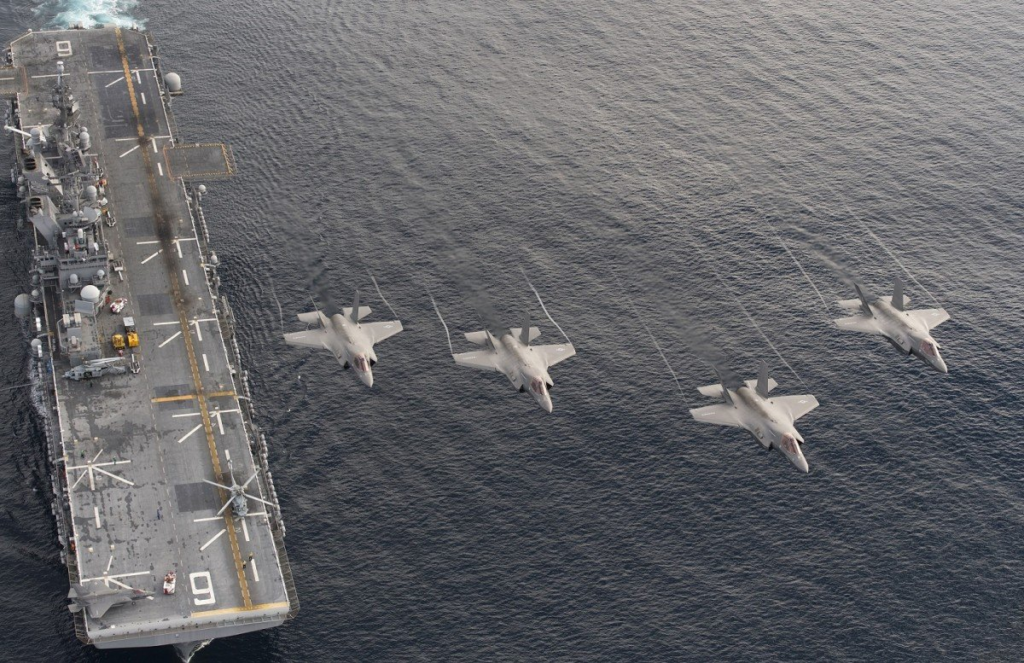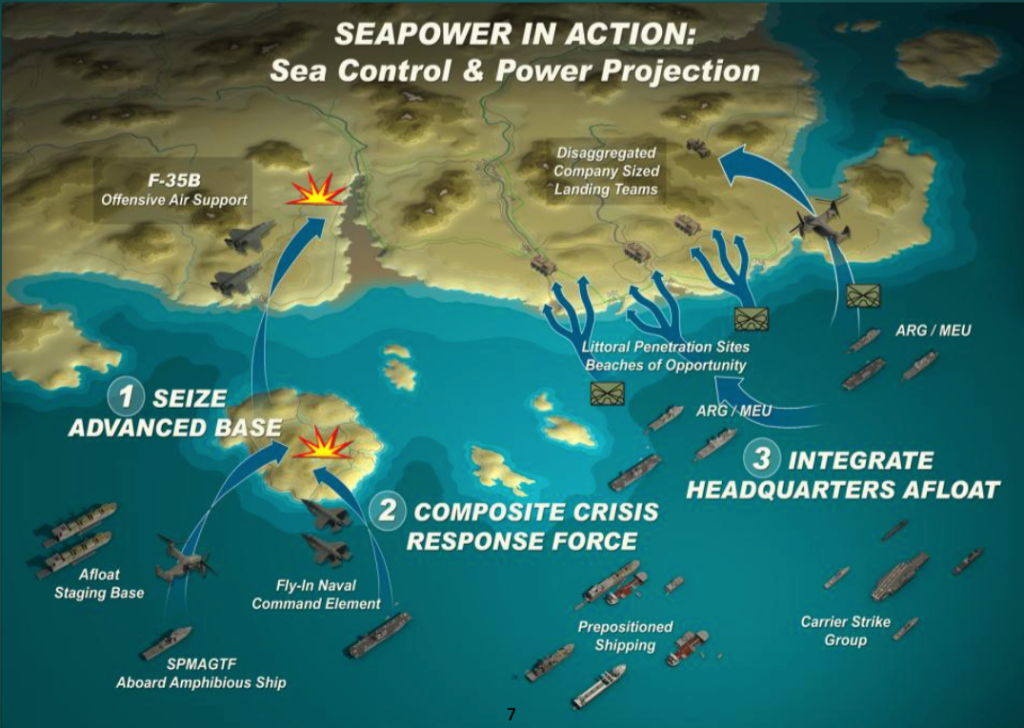
The US Marine Corps (USMC) is practicing some new concepts of operation (CONOPS), using their new F-35B aircraft. The combination of a stealthy, Short-Take-Off-Vetical-Landing (STOVL) fighter with great sensors, with the aviation-centric configuration of the America Class vessels; the “Lightening Carrier (CV-L)” concept, and the flexible basing options from their CONOPS have some great potential to rapidly extend the power of the USMC ashore. “After fifteen years of emphasizing sustained operations ashore, the Marine Corps is refocusing on its naval and expeditionary roots and full-spectrum operations across the range of military operations (ROMO).” (2017 Marine Aviation Plan)
The 21st century Marine Air Ground Task Force (MAGTF) conducts maneuver warfare in the physical and cognitive dimensions of conflict to generate and exploit psychological, technological, temporal, and spatial advantages over the adversary. The 21st century MAGTF executes maneuver warfare through a combined arms approach that embraces information warfare as indispensable for achieving complementary effects across five domains – air, land, sea, space, and cyberspace. The 21st century MAGTF avoids linear, sequential, and phased approaches to operations and blends maneuver warfare and combined arms to generate the combat power needed for simultaneity of action in its full range of missions. The 21st century MAGTF operates and fights at sea, from the sea, and ashore as an integrated part of the naval force and the larger combined/joint force. (emphasis added) (ibid)
The concepts laid out in the USMC document are:
- Distributed Aviation Operations (DAO) – this is a plan to reduce predictability and operate from austere locations, “independent of specialized fixed infrastructure”
- Distributed STOVL Operations (DSO) – similar to DSO, but with “[F]uel and ordnance resupply conducted at mobile forward arming and refueling points (M-FARPS) located closer or within the operating area.”
- “Complementing…is the mobile distribution site (MDS) concept, a vehicle-mobile site located away from the M-FARP, intended to re-arm and re-fuel the M-FARP while maintaining an element of deception and decoy. DSO is sustainable using surface connectors, land-based MDSs and host nation support, enabling readiness and sortie generation for the MAGTF.”
We might never need to employ this way…but to not lean forward to develop this capability, to train and exercise with it, is to deny ourselves a force multiplier that highlights the agility and opportunity only the Navy-Marine Corps team can provide. (ibid)

How Do These USMC Lightening Carriers Compare?
The America Class amphibious assault ship, which at ~45,000 ton displacement is larger that the French nuclear carrier Charles De Gaulle (~42,000 tons), and approaching the size of the Russian and Chinese Kuznetsov class carriers (~55,000 tons), about the same size as the Indian modified Kiev class carrier (~45,000 tons), and bigger than the Japanese Izumo Class “helicopter destroyer” (~27,000 tons), which to a layman’s eyes is an aircraft carrier; even though these vessels operate only helicopters today, the capability to operate F-35B aircraft in the future is certainly exists. Of course the dominant carrier force is the US Navy’s Nimitz class, and newer Ford class (~100,000 tons), which operate aircraft using Catapult-Assisted-Take-Off-But-Arrested-Recovery (CATOBAR). Interestingly, the British initially designed their Queen Elizabeth class carriers (~70,000 tons) to be CATOBAR, which gives the advantage of being able to launch heavier fighters (i.e. more weapons and fuel). A doubling of the estimated cost for CATOBAR forced a redesign back to a STOVL design back in 2012.
Are STOVL Aircraft Inherently Inferior?
This is an excellent question. The physical laws of nature have a vote here, because a STOVL aircraft must carry a smaller payload, than a CATOBAR aircraft, since it lacks the initial thrust provided by the catapult. David Axe of War is Boring has delivered a scathing account of the STOVL concept and history, (to again target the F-35). The USMC pursued STOVL technology, in spite of ” …crash-plagued experimentation throughout the early years of the jet age — every STOVL or V/STOL prototype from 1946 to 1966 crashed. “USMC interest in a working V/STOL attack aircraft outstripped the state of aeronautical technology.”
The British, meanwhile, concerned about Russian bomber and missile attacks on their airfields during the Cold War, developed the Harrier Jump Jet, which did not require a lengthy, fixed runway.
But the Harrier, so appealing in theory, has been a disaster in practice … In the 1991 Gulf War, the front-line concrete lily pads never showed up, so the jump jet had to fly from distant full-size bases or assault ships. With their very limited fuel, they were lucky to be able to put in five or 10 minutes supporting Marines on the ground — and they proved tremendously vulnerable to machine guns and shoulder-fired missiles.
Indeed, Mr. Axe quotes the infamous Pierre Sprey – “The Harrier was based on a complete lie.” (emphasis added).
Was The Harrier Really That Bad?
Some claim that the Sea Harrier [is] the forgotten hero that won the war in the Falklands. The US Air Force air chronicles states …
Harrier jump-jets performed well beyond the performance expectations of most military experts. The remarkable record of the aircraft is attributed not only to relatively sophisticated gadgetry, such as warning receivers and electronic countermeasures to confuse Argentine antiaircraft weapons, but also to the skilled British pilots…and the older Argentine planes…. In spite of its spectacular successes against British ships, Argentina lost the air-to-air war decisively. Argentine fighter aircraft failed to shoot down a single Harrier. British Harrier losses totaled nine–four to accidents and five by surface-based air defenses–surface-to-air missiles (SAMs) and antiaircraft artillery (AAA).
The USMC concepts specifically called out the ability to exploit spatial advantages, which also played a key roll in the Falklands:
The 400 miles from Argentina to the islands partially explained why the score was so lopsided. To make the 800-mile round trip from the Rio Gallegos Air Base on the coast severely strained the maximum operating range of the Argentine aircraft. Consequently, Argentine pilots had all they could do to reach the conflict area undetected and deliver their ordnance, “getting in and getting out” as quickly as possible.” (Ibid)
This geo-spatial situation is reminiscent of the Battle of Britain, where the RAF operated fighter aircraft nearby the battle location, while the Luftwaffe operated at the edge of their range, a limitation which was also widely credited as an important factor in the outcome.
The US Navy’s account of the Falklands War gave similar credit to the Harrier’s effectiveness:
[T]he Royal Navy was forced to go to war with only two short vertical takeoff and landing (STOVL) ships and their STOVL aircraft, the Harrier…. [T]hese units performed very well. It has been stated that had the British not had aircraft with the capabilities of the Harrier (STOVL, high reliability, and high availability) and the two small ships to operate them, it is unlikely the United Kingdom would have committed itself to hostilities in the South Atlantic…. Perhaps its greatest feature was surprising flexibility…. One of the best features of the Harrier was versatility in operating from a variety of platforms under actual combat conditions.
It is precisely this flexibility that STOVL aircraft—both the F-35B and the Harrier before it—which is leveraged in the USMC concepts. The F-35B has the added advantage that one of its key capabilities is the delivery of timely, accurate information. This information is delivered across the battle network at the speed of light, and weighs nothing, so the STOVL limitations do not apply in the same way. It seems clear that any evaluation of the F-35B’s capabilities need to consider these advantages, rather than focusing exclusively on metrics related to the Energy-Maneuverability Theory, such as wing loading, thrust to weight ratio.
